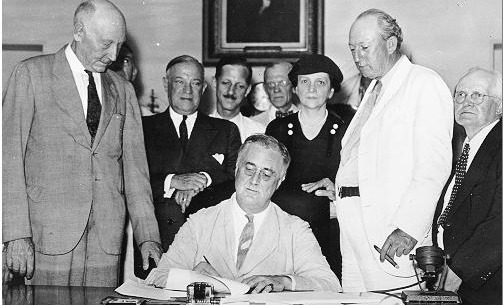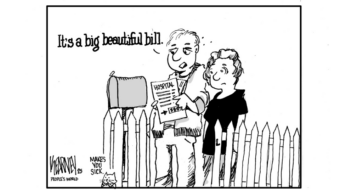
What if this is 1935 and Congress is getting ready to vote on the Social Security Act?
As political progressives, union activists or whatever, do you support the bill or oppose it?
No-brainer, right?
So what if I told you that by supporting the 1935 Social Security Act you would be selling out the working class and capitulating to right-wing special interests who wrote half the bill?
Didn’t see that one coming, didja?
To get Social Security passed, progressives had to agree to exclude nearly one-half of the working class, including two-thirds of all African Americans and more than one-half of all women.
Yep, that’s the deal you would have had to make in 1935 to pass what we know now is one of the most progressive and successful governmental programs of all time. But in 1935, it didn’t look that way when progressives had to accept the deal racist, reactionary Southern Democrats laid down in exchange for their votes.
These backward elements held power over key committees that could have scuttled Social Security and prevented even a vote. Their deal? Exclude all domestic workers, agricultural labor, state and local government employees, and many teachers, nurses, hospital workers, librarians and social workers. Their special interest? Keeping power by keeping intact the American-style apartheid system they presided over.
So what do we do? Kill the bill and try to come back later or take what you can get now?
Remember this deal was made by progressives during the left’s glory days. That’s when we had one of the most progressive presidents ever in the White House, the most progressives ever in Congress and the biggest mass movement ever out in the streets. And progressives still had to cut a deal with the Devil.
Protesting is easy. Governing is a bitch.
So let’s bring this “what if” game to the present.
What if you are a member of Congress in 2009: do you vote for the deal cut in the Senate or vote to kill the bill?
Not so easy anymore, is it?
We know the flawed Social Security bill was strengthened over the years, adding household workers in 1950 and agricultural, hotel, laundry and state and local government workers in 1954. What we don’t know is the future of the current flawed health care bill.
The one nice thing we do know is that improving it will be a lot easier than passing the original bill. As New York Times columnist Paul Krugman pointed out, many of the future improvements can be done through reconciliation with a simple majority vote as opposed to the anti-democratic, super-majority 60-vote process that gave the sociopath Joe Lieberman power to kill the public option and prevent lowering the enrollment age for Medicare to 55.
So what do we do now?
We still have to figure that one out. But one thing we can’t afford to do is make single-payer a dogma. Such rigidity in strategy ties our hands and limits our options. Looking at the world, we see that more nations accomplished the goal of health care for all through a multi-payer system, not a single-payer one. Only Canada, Taiwan and South Korea have chosen to go single-payer.
France is considered to have the world’s best health care system while Japan has the longest healthy life expectancy. Single-payer systems? Hardly. French citizens are covered by 14 private insurance companies. The Japanese have about 3,500 private health insurance plans. These multi-payer systems succeed because private insurers there are not allowed to make a profit selling health insurance.
Every nation that has committed itself to providing health care for all its citizens has followed its own unique path to get there. It’s a sure bet the United States will never adopt the socialized medicine system of Great Britain, even though our Veterans Administration already is a socialized system with government-owned, government-run hospitals and government-hired doctors.
We could build on this flawed health care bill by expanding Medicare to all Americans of all ages. That would be the most direct route to single payer since the structure already exists, is quite popular (even Tea Baggers love their Medicare) and operates way more efficiently than private insurance with its 3 percent administrative costs verses 20 percent to 30 percent for private insurers.
But it’s not certain that most Americans are prepared to kill a whole industry even if many of the clerical workers are absorbed by Medicare to serve the new enrollees.
The private sector has always had a role in our government-run health care. Most of the Medicare workers who process and pay claims are employees of private insurance companies. That was the result of a deal struck in 1965 to help win support for passage of Medicare.
The creation of health insurance exchanges under both the House and Senate bills and the Senate’s provision that private insurance companies must reduce their administrative costs to 10 percent could move us in the direction of a French-German-Japanese-Swiss model. In these and other multi-payer countries, private insurers collect premiums set by government regulation, pay all claims immediately under rates set by government negotiations with doctors and hospitals, and cannot deny coverage for any reason under strict government regulation.
So what if it turns out that most Americans decide they prefer a multi-payer over a single-payer health care system?
Protesting is easy. Governing is a bitch.
Photo: President Franklin Delano Roosevelt signs the Social Security Act on Aug. 14, 1935. Standing with Roosevelt are Rep. Robert Doughton, D-N.C., unknown person in shadow; Sen. Robert Wagner, D-N.Y., Rep. John Dingell, D-Mich., unknown man in bowtie; Secretary of Labor Frances Perkins, Sen. Pat Harrison, D-Miss., and Rep. David Lewis, D-Md. (www.ssa.gov/history/)










